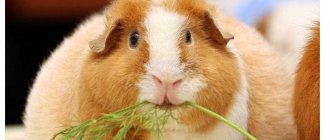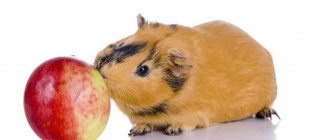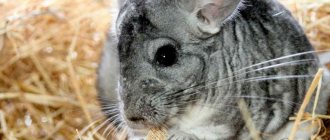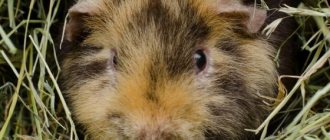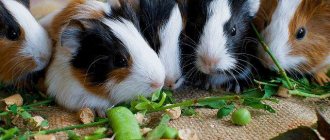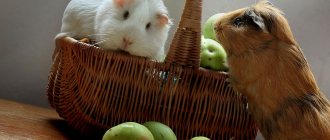One of the most important components of a guinea pig's diet is green food. This food is inexpensive, contains all the necessary nutrients, and is easily eaten and absorbed by animals. Is it possible for guinea pigs to have fresh grass, and what kind of grass can be fed to these pets we will look at in our article.
All sown cereals and legumes, as well as meadow, steppe and forest grasses can be used as green fodder. The most useful are mixtures of legumes and cereal-legume herbs, containing large amounts of protein, vitamins and minerals. This can be Sudan grass, peas, clover, lupine, alfalfa, sweet clover, vetch, sainfoin, corn, winter rye, etc.
As green food, pigs can be given wild herbs - nettle, plantain, wheatgrass, yarrow, dandelion, rapeseed, sage and others. You can also offer these rodents tops of melons or garden crops, leaves, shoots and twigs from some bushes and trees.
Now let's take a closer look at each type of green food and determine what is beneficial for guinea pigs and what is not.
Dandelion
The most common question is: can guinea pigs eat dandelions? Dandelion is one of the most common plants, growing in a variety of places - in vegetable gardens, orchards, parks, fields, lawns, and also near roads.
You can give your guinea pig all parts of the plant - leaves, flowers, root and stem. But only the leaves and roots of this plant have nutritional value. Dandelion leaves contain carotene, choline, vitamin C, potassium, calcium, and iron. Inulin, sucrose, organic acids, various vitamins and microelements accumulate in the roots.
Dandelion leaves can be fed from early spring until late autumn. Substances contained in the leaves and roots of this plant stimulate appetite, enhance digestion, and cleanse the blood. But this plant cannot be given in large quantities. The amount of dandelion fed should not exceed 30% of the total daily intake of all green food.
Poisonous plants
When going to collect herbs for your beloved pet, you need to remember that there are a number of poisonous plants that not only cause poisoning, but also lead to death.
Plants that are poisonous and dangerous to guinea pigs include:
- Fighter,
- Arum,
- white acacia,
- Common aloe
- Common and lemon geraniums,
- All types of ferns,
- All types of lilies,
- Sorrel,
- Nightshade,
- Henbane,
- Lilies of the valley,
- All varieties of narcissus,
- Hyacinths,
- Celandine.
The following are considered dangerous for animals:
- Bay leaf,
- Gorse,
- All types of wisteria,
- Yew,
- All varieties of ivy,
- Deren,
- Common broom,
- Dogwood and all varieties of honeysuckle.
Nightshade is a very poisonous plant and leads to death.
Of the tree species it is strictly forbidden to feed:
- Thuja and oleander sprigs,
- Biryuchina,
- Juniper shoots and roots,
- Berries, leaves and twigs of elderberry,
- mistletoe,
- Leaves, shoots and twigs of hellebore and belladonna.
Plantain
Can guinea pigs eat plantain? Plantain leaves contain potassium, carotene, citric acid, vitamin C, tannins, and alkaloids. Plantain is an anti-inflammatory, sedative, helps with digestive system disorders, scabies and allergies.
Consuming plantain reduces blood sugar levels. This plant has been used to treat diabetes since the times of Ancient Greece and Rome. Plantain is especially indicated for complicated forms of diabetes. In a limited form, this plant can be given to guinea pigs.
Stem
The fresh stalk contains bitterness, tannins, mucus and juice, which have a beneficial effect on the health of the pet. The animal eats the crispy stems with gusto, but despite this, care must be taken to ensure that the juicy delicacy only brings benefits. Pre-washed and dried stems are given in an amount of grams not exceeding 15% of the animal’s weight.
Dandelion stem contains tannins, which is very beneficial for pigs
Chamomile
The inflorescences of chamomile or chamomile contain essential oil, azulene, choline, organic acids, carotene, vitamins, etc. Chamomile is used as an anti-inflammatory, antispasmodic and carminative. The most valuable is the essential oil of this plant, which has a disinfectant, analgesic, and diaphoretic effect.
It is recommended to give chamomile for bloating in the form of tea or herbs; for diarrhea, give a strong decoction - 0.5 tbsp. for 1 tbsp. water three times a day. You should not collect chamomile near roads and railway lines, near landfills, animal farms and oil storage facilities - chamomile absorbs toxic substances from groundwater and the environment. It is better to collect in a forest or field, away from roads.
How to process correctly
It is important to know not only what grass can be given to pet rodents, but also how to process it correctly. Grass collected in the ecozone does not need to be washed. It is worth remembering that water only washes away the remaining dust, but does not eliminate the toxic substances that the greenery has absorbed.
It is strictly forbidden to process green food with boiling water. Heat-treated herbs should not be fed to these animals. Some breeders believe that in this way they can destroy parasite eggs, but this is deeply misleading. It is impossible to destroy them by heat treatment.
In addition, heat treatment of greens makes it absolutely useless for the animal’s body, since under such influence all useful substances are destroyed.
It is not recommended to give a lot of fresh greens after wintering. An animal that is not accustomed to succulent food may get sick. Most often this provokes gastrointestinal upset, diarrhea and vomiting.
Sorrel
Can guinea pigs eat sorrel? Sorrel contains proteins, fiber, carbohydrates, oxalic acid, folic acid, thiamine, ascorbic acid and other vitamins. This plant is a rich source of potassium and also contains calcium, sodium, phosphorus, chlorine, copper, zinc and other substances.
Sorrel can be given to guinea pigs, only in small quantities and not every day. It is not recommended to give horse sorrel to pigs.
Sorrel, like dandelion, when fed in large quantities, can cause bloating or upset the pet's digestive system. Due to the presence of oxalic acid, when consuming large amounts of this plant for a long time, a violation of mineral metabolism in the body and kidney stones may occur. Therefore, sorrel grass can be given to guinea pigs in limited quantities.
Grains, nuts and seeds
Most guinea pig owners purchase ready-made grain mixtures. As a rule, animals calmly eat purchased food in combination with succulent foods and feel great for some time. However, if the owner of the rodent did not pay attention to the nutritional pattern of his ward, the animal may soon begin to have health problems.
Some pigs choose from a grain mixture and eat only sweet dried fruits and seeds, which contain a lot of fats and carbohydrates. This often leads to obesity, liver disease, and heart failure. The most common symptoms of animal malnutrition are:
- diarrhea;
- bloating;
- the appearance of dental problems;
- constipation;
- shifting the nutritional balance from succulent feed to grain.
If at least 2 of the listed signs are observed, it is necessary to urgently change the grain mixture. You should choose a composition with a lower carbohydrate content, which has a predominant amount of wild grains.
You can prepare the grain mixture yourself. But it is important to remember that cereals should not be boiled or scalded with boiling water. They are mixed with grains and given to pets in small quantities (30% of the diet).
Table 5. Permitted and prohibited components of the grain mixture.
| Can | It is forbidden |
| Barley grains, lentils, rolled oats, oats (unpeeled), pearl barley. | Millet, corn grits, rice grains, buckwheat. |
When choosing combinations of grain mixtures, it is necessary to take into account the age of the animal, the degree of its mobility, the time of year, and the weight of the rodent. This will help avoid problems with obesity and the development of gastrointestinal pathologies.
Corn
Can guinea pigs eat corn? Young green corn, containing a large amount of sugar, is very nutritious and economically beneficial as green fodder. This food is great for guinea pigs. Young corn should be used as food for guinea pigs from the beginning of eruption until the panicle is thrown out. Adult rodents are given up to 70%, and young rodents - up to 40% of the daily requirement of green food. It is best to use a mixture of corn with alfalfa, clover and other grasses.
Prohibited:
1. Collect grass near roads, in places where animals are walked and grazed, near landfills, industries with harmful emissions, as well as grass that has been treated with pesticides or fertilizers.
2. Collect grass in places where there is a high number of ticks. These insects can hide in the grass and then very easily attach themselves to your pet.
Fruits
The main criteria when choosing fruit treats for pigs are:
- As little sugar as possible.
- A decisive “no” to sour foods.
- Use only ripe and fresh fruits.
Before giving fruit to animals, they are washed, scalded with boiling water, cut into small pieces, and the seeds are removed. It is advisable not to determine the amount of treats by eye; it is better to consult with a veterinarian about how much fruit you can give to a particular animal.
Table 4. How often can fruit be added to the rodent menu.
| 4–5 times a week | 1–2 times a week | 1 time per month |
| Apple, pear. | Banana, persimmon, orange, tangerine. | Pineapple, mango, kiwi, grapes, guava. |
Important! It is forbidden to give lemon to guinea pigs.
Fruits are a healthy part of a guinea pig's diet. These products diversify the diet and compensate for the lack of essential minerals and amino acids. However, moderation in the amount of treats should be observed. This is necessary to protect pigs from the development of allergic reactions and gastrointestinal disorders.
Important! Under no circumstances should guinea pigs be given citrus fruit zest or banana peels.
Results
In moderate doses, fresh grass can be added to the daily diet of guinea pigs. But before you offer your pet fresh grass, be sure to check out what properties it has and whether your pig can eat this particular type of green food.
Did you like the article? Share with friends: [supsystic-social-sharing id=”1"]
- Related Posts
- Diagnosis, symptoms and treatment of worms in guinea pigs
- Skinny Guinea Pig
- Coronet guinea pigs
« Previous entry
Green feed
Many breeders, especially beginners, do not know what type of succulent green food they can offer their pets. After all, some herbs are dangerous not only to the life, but also to the health of domestic rodents.
We invite you to familiarize yourself with a fairly extensive list of permitted herbs:
- dandelion roots and leaves;
- sow thistle;
- shepherd's purse;
- coriander;
- peas;
- sprigs of dill, parsley;
- lettuce leaves;
- cilantro;
- celery;
- nettle;
- leaves and stems of beans, peas;
- leaves of plantain, yarrow;
- young corn shoots.
Ryegrass, vetch, sweet clover, oats and winter rye complete the list of permitted products.
Water
There must be a drinking bowl with fresh water in your pet's cage. An adult animal needs 250 ml of fluid per day, but a pregnant female needs a little more. It is recommended to buy a drinking bowl for your pet. In such a device, the water will not become dirty or spill.
It is advisable to give the rodent bottled or filtered water rather than boiled water. The owner must carefully ensure that dirt and debris do not get into the drinking bowl. By consuming contaminated water, your guinea pig can contract an infection.
Foods harmful to guinea pigs
The following is a list of foods that can cause serious harm to a rodent's body:
- white and black bread, pasta;
- meat and dairy products;
- potato;
- mushrooms;
- baked goods, sweets;
- cereals, dry legumes;
- fruit and berry seeds;
- radish, radish;
- sorrel, rhubarb;
- juice, tea, jelly and other drinks other than water;
- leaves of indoor plants that are poisonous to rodents;
- canned food, spices, cheese and other delicacies;
- waste from the human table.
Guinea pigs love to chew on young tree branches. You should not give your pet oak, willow, pine, spruce, rowan, hornbeam, or elm branches. But you can safely put cherry, hazel, plum, apple, and pear branches in the feeder.
